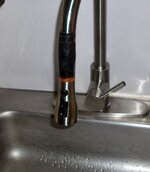PCeBiker
No-Hands No-Pedaling No-Credentials
- Region
- Canada
She's a good sport to re-enact that episode so you could take pictures for us!
I saved all her baby pictures.
She's 9½ years old now and hasn't had a bath since she was 6 months old.
She went Fricken Nuts when she was 9 months old so I had to get her fixed.
That calmed her down.
Nowadays I'd make it easy on the cat by exposing fleas with an electric shaver.
I use this once a month now.
It kills everything except the cat.
You have the same faucet handles I had from 1985 until this year. I was worried because I couldn't even remember what brand it was, to order replacement parts.
I replaced the valve seals a few times until it was time to replace the valves.
The valves were old-school where the hot water valve was reverse thread with a heat resistant heavy duty build so the tap wouldn't dwindle to a trickle when the hot water got to it and heated it up.
I was told at the hardware store that they don't make those anymore and they just use the same cold water valves for hot and cold.
He got a kick out of my hot water valve. He hadn't seen one in over a decade.
I installed a new faucet a couple of years ago,..
When the handle is at 1 o'clock, it's cold, and 11 o'clock is hot.
I put cold at 1 o'clock and hot at 11 o'clock.
I also put a separate valve on the hot water line to turn down the maximum water flow so that I don't waste hot water.


